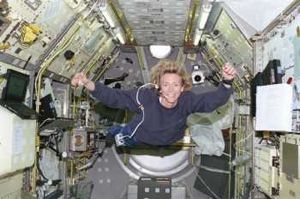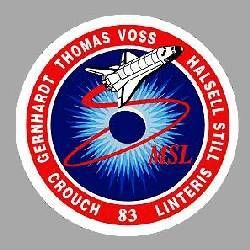
Home - Search - Browse - Alphabetic Index: 0- 1- 2- 3- 4- 5- 6- 7- 8- 9
A- B- C- D- E- F- G- H- I- J- K- L- M- N- O- P- Q- R- S- T- U- V- W- X- Y- Z
STS-83
 STS-83 |
AKA: Columbia;MSL-1. Launched: 1997-04-04. Returned: 1997-04-08. Number crew: 7 . Duration: 3.97 days.
The launch was postponed for a day to replace some insulation around a water coolant line in Columbia's payload bay. Liftoff was further delayed 20 minutes due to anomalous oxygen readings in the orbiter's payload bay. STS-83 was cut short due to a problem with one of the three fuel cells that provide electricity and water to Columbia (flight rules required that all three must be operating). At 14:30 GMT on April 6 the crew were ordered to begin a Minimum Duration Flight (MDF). On April 8 the OMS engines ignited at 17:30 GMT for the deorbit burn, and Columbia landed on Runway 33 at Kennedy Space Center at 18:33 GMT.
With delays in International Space Station construction leaving ample room in the shuttle schedule, NASA made the unique decision to leave the equipment installed in Columbia and refly this mission with the same crew later in 1997 as STS-94.
The launch came at 1920:36 GMT on Apr 4. Solid rocket motors RSRM-59 separated two minutes after launch and the external tank ET-84 was jettisoned at 19:29 GMT, leaving Columbia in an elliptical transfer orbit with an apogee near 300 km. The OMS 2 orbit circularization burn came at 20:00 GMT. Columbia opened its payload bay doors by 21:09 GMT, beginning what was intended as a marathon Spacelab research mission.
Cargo Bay Payloads:
In-Cabin Payloads: SAREX, MSX
The mission this time went for its full two week duration as the crew conducted the full list of experiments. The deorbit burn was at 0944 GMT following payload bay door closing at around 0700 GMT. Columbia landed on KSC's Runway 33 at 1046:34 GMT on Jul 17.
Development Test Objectives / Detailed Supplementary Objectives / Risk Mitigation Experiments
NASA Official Mission Summary:
STS-83
(MSL-1)
Columbia
Pad A
83rd Shuttle mission
22nd flight OV-102
Shortened mission
(3rd due to technical problem)
36th KSC landing
Crew:
James D. Halsell Jr., Commander (3rd Shuttle flight)
Susan L. Still, Pilot (1st)
Janice Voss, Payload Commander (3rd)
Michael L. Gernhardt, Mission Specialist (2nd)
Donald A. Thomas, Mission Specialist (3rd)
Roger K. Crouch, Payload Specialist (1st)
Gregory T. Linteris, Payload Specialist (1st)
Orbiter Preps (move to):
OPF - Dec. 7, 1996
VAB - March 5, 1997
Pad - March 11, 1997
Launch:
April 4, 1997, 2:20:32 p.m. EST. Launch originally set for April 3 delayed 24 hours on April 1 due to a requirement to add additional thermal insulation to a water coolant line in the orbiter's payload bay. Managers determined that the line, which cools various electronics on the orbiter, was not properly insulated and could possibly freeze on-orbit. Liftoff delayed 20 minutes, 32 seconds, due to an orbiter access hatch seal which had to be replaced.
Landing:
April 8, 1997, 2:33:11 p.m. EDT, Runway 33, Kennedy Space Center, Fla. Rollout distance: 8,602 feet (2,622 meters) Rollout time: 59 seconds. Mission duration: three days, 23 hours, 12 minutes, 39 seconds. Landed on revolution 64, on the first KSC opportunity for the day.
Mission Highlights:
First flight of the Microgravity Science Laboratory-1 (MSL-1) cut short due to concerns about one of three fuel cells, marking only third time in Shuttle program history a mission ended early. (STS- 2, 1981 and STS-44, 1991 were other two times). Fuel cell No. 2 had shown some erratic readings during prelaunch startup, but was cleared to fly after additional checkout and test. Shortly after onorbit operations began, the fuel cell no. 2 substack no. 3 differential voltage began trending upward.
There are three fuel cells on each orbiter, each containing three substacks made up of two banks of 16 cells. In one substack of fuel cell no. 2, the difference in output voltage between the two banks of cells was increasing. The fuel cells use a reaction of liquid hydrogen and liquid oxygen to generate electricity and produce drinking water. Although one fuel cell produces enough electricity to conduct on-orbit and landing operations, Shuttle flight rules require all three to be functioning well to ensure crew safety and provide sufficient backup capability during reentry and landing.
When a purge failed to halt the upward trend, the fuel cell was disconnected from the orbiter's power system. Additional purges and other measures failed to correct the anomaly, and around 10 a.m., April 6, the Mission Management Team opted to end the mission early. Fuel cell no. 2 was shut down later that afternoon.
Crew was able to conduct some science in the MSL-1 Spacelab module despite the early return. Work was performed in the German electromagnetic levitation furnace facility (TEMPUS) on an experiment called Thermophysical Properties of Undercooled Metallic Melts. This experiment studies the amount of undercooling that can be achieved before solidification occurs. Another experiment performed was the Liquid-Phase Sintering II experiment in the Large Isothermal Furnace. This investigation uses heat and pressure to test theories about how the liquefied component bonds with the solid particles of a mixture without reaching the melting point of the new alloy combination.
Also conducted were two fire-related experiments. The Laminar Soot Processes experiment allowed scientists to observe for the first time the concentration and structure of soot from a fire burning in microgravity. An experiment on the Structure of Flame Balls completed two runs. This experiment is designed to determine under what conditions a stable flameball can exist, and if heat loss is responsible in some way for the stabilization of the flame ball during burning.
A decision to refly the mission in its entirety was made by the Mission Management Team in the days following Columbia's return. The reflight was first unofficially designated STS-83R and then officially named STS-94.
More at: STS-83.
Family: Manned spaceflight. People: Crouch, Gernhardt, Halsell, Kilrain, Linteris, Thomas, Voss, Janice. Country: USA. Spacecraft: Columbia. Projects: STS. Launch Sites: Cape Canaveral. Agency: NASA, NASA Houston.
 | STS-83 Credit: www.spacefacts.de |
1997 April 4 - . 19:20 GMT - . Launch Site: Cape Canaveral. Launch Complex: Cape Canaveral LC39A. Launch Platform: MLP3. LV Family: Shuttle. Launch Vehicle: Space Shuttle.
- STS-83 - .
Call Sign: Columbia. Crew: Crouch,
Gernhardt,
Halsell,
Kilrain,
Linteris,
Thomas,
Voss, Janice.
Backup Crew: Coleman, Catherine.
Payload: Columbia F22 / Spacelab LM Unit 1 / EDO. Mass: 115,900 kg (255,500 lb). Nation: USA.
Agency: NASA Houston.
Program: STS.
Class: Manned.
Type: Manned spaceplane. Flight: STS-83.
Spacecraft Bus: Shuttle.
Spacecraft: Columbia.
Duration: 3.97 days. Decay Date: 1997-04-08 . USAF Sat Cat: 24755 . COSPAR: 1997-013A. Apogee: 302 km (187 mi). Perigee: 298 km (185 mi). Inclination: 28.50 deg. Period: 90.50 min.
The launch of STS-83, the first Microgravity Science Laboratory (MSL-1) mission, was postponed for a day to replace some insulation around a water coolant line in Columbia's payload bay. Liftoff was further delayed 20 minutes due to anomalous oxygen readings in the orbiter's payload bay. STS-83 was cut short due to a problem with one of the three fuel cells that provide electricity and water to Columbia (flight rules required that all three must be operating). At 14:30 GMT on April 6 the crew were ordered to begin a Minimum Duration Flight (MDF). On April 8 the OMS engines ignited at 17:30 GMT for the deorbit burn, and Columbia landed on Runway 33 at Kennedy Space Center at 18:33 GMT.
With delays in International Space Station construction leaving ample room in the shuttle schedule, NASA made the unique decision to leave the equipment installed in Columbia and refly this mission with the same crew later in 1997 as STS-94.
1997 April 8 - .
- Landing of STS-83 - . Return Crew: Crouch, Gernhardt, Halsell, Kilrain, Linteris, Thomas, Voss, Janice. Nation: USA. Related Persons: Crouch, Gernhardt, Halsell, Kilrain, Linteris, Thomas, Voss, Janice. Program: Spacelab. Flight: STS-83. STS-83 landed at 18:33 GMT. .
Back to top of page
Home - Search - Browse - Alphabetic Index: 0- 1- 2- 3- 4- 5- 6- 7- 8- 9
A- B- C- D- E- F- G- H- I- J- K- L- M- N- O- P- Q- R- S- T- U- V- W- X- Y- Z
© 1997-2019 Mark Wade - Contact
© / Conditions for Use